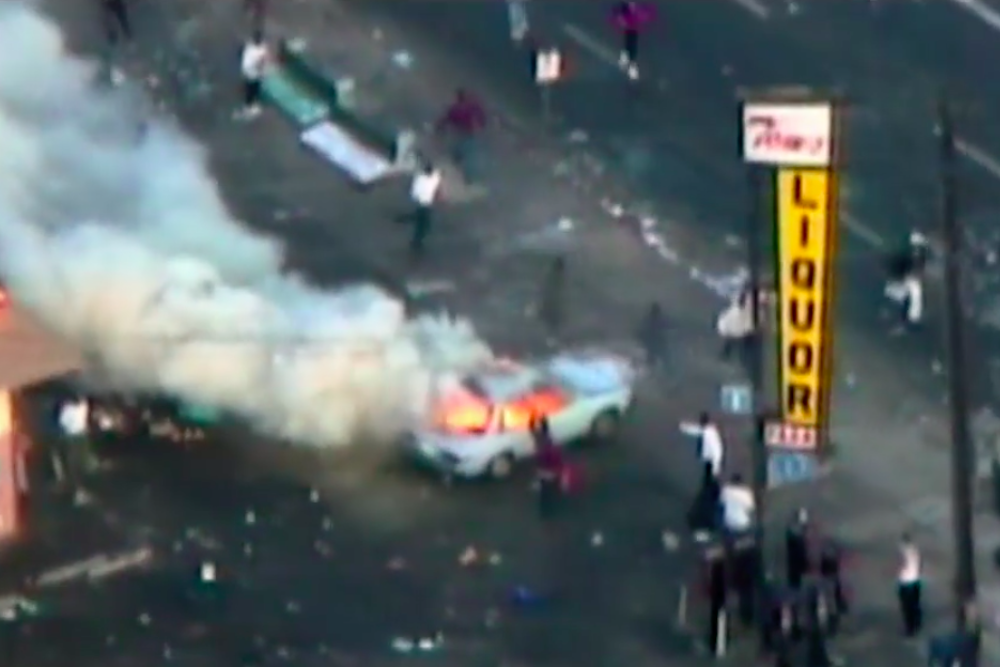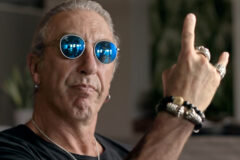“This is happening every day. They just caught it on videotape,” says Michael Winters, a resident of South Central Los Angeles, early in the A&E documentary L.A. Burning: The Riots 25 Years Later. He’s talking about the footage that helped spark an uprising in his neighborhood, one that left more than 60 people dead and over 1,000 properties looted or burned. The footage shows 25-year-old Rodney King, crawling and writhing and eventually lying still on the ground, as four Los Angeles Police Department officers kicked and beat him with a flurry of metal batons.
After two and a half decades and endless loops on TV news across America, the Rodney King video is still a shocking thing to watch. But as Winters points out, when black people in South Central took to the streets on April 29, 1992, they were not reacting with shock to the footage, or to the acquittals of the four officers that followed. They didn’t have the sense, as some white families who watched the video at home surely did, that the King beating was an aberration. This was happening every day in South Central. This time, they just caught it on videotape. Later in the film, a retired L.A.P.D. officer explains that the cops in the King tape conducted themselves according to departmental policy, a statement intended as a kind of defense of the police that comes out sounding like an indictment.
L.A. Burning, which premiered April 18, is one of five new documentaries about the King verdict and the riots that followed. The others are Let It Fall: Los Angeles 1982-1992, directed by 12 Years a Slave screenwriter John Ridley, which was released in limited theaters and premiered in a slightly abridged version on ABC; Burn, Motherf*cker, Burn!, directed by Sacha Jenkins and airing on Showtime; LA 92, directed by Daniel Lindsay and T.J. Martin and airing on National Geographic; and an episode of the Smithsonian Channel’s Lost Tapes series that focuses on the riots. Employing much of the same archival footage and interviews with several of the same key players, each of the films aims to provide fresh perspective on a familiar American story, one that feels like a fiery prologue to the police killings of black men and ensuing protests that have consumed the nation over the last several years.
On March 3, 1991, King was driving home from a friend’s house, where he had been watching basketball and drinking, when California Highway Patrol officers attempted to pull him over for speeding on the Foothill Freeway. King was on parole for an earlier robbery, and refused to stop, leading the officers on a high-speed chase. Eventually, he pulled over in front of an apartment building. The L.A.P.D. arrived on the scene to apprehend him, and as the four officers began to beat and tase King, at least a dozen others stood around and watched. George Holliday, an amateur videographer who lived in the adjacent building, had recently purchased a new camera, and started filming from his window when he heard the sirens outside. Decades before the rise of ubiquitous cell phone cameras, it was Holliday’s snap decision to document the King beating that turned it from business as usual in early ‘90s L.A. into an event of historical importance.
As if to underscore this point, L.A. Burning opens with a reel of heart wrenching recent footage: Philando Castile’s girlfriend struggling to keep her composure while he bleeds to death in the car seat next to her, Eric Garner pleading for air as an NYPD officer chokes him. The film’s most effective argument emerges subtly from these clips and interviews with the people who were there in L.A.: that the indignation behind the King riots and the Black Lives Matter movement arises not just from the beatings and killings that are broadcast on the evening news, but from all of those that were never captured on tape in the first place.
L.A. Burning, which was executive produced by Boyz n the Hood director and native South Central Angeleno John Singleton, is just 87 minutes long. The film makes frequent use of a montage-like editing style, and you occasionally get the sense that the directors are struggling to fit their wide historical scope inside its compact made-for-TV runtime. The majority of the film focuses on the action of the riots themselves: Important factors like the trial and acquittal of L.A.P.D. officers Stacey Koon, Laurence Powell, Timothy Wind, and Theodore Briseno, and the specifics of the black community’s discontent with the police in the years leading up to the King incident, are given comparatively little screen time.
On the second day of unrest, rioters and armed shopkeepers turned Koreatown into a warzone, fueled in part by anger over the killing of 15-year-old Latasha Harlins by a Korean store owner just days after the King beating. In one new interview from L.A. Burning, a retail employee seen exchanging handgun fire with rioters in footage from that day looks back on his fears and motives during the gunfight with chilling matter-of-factness. In another interview, retired L.A.P.D. lieutenant Michael Moulin, the ranking police official on the scene during the first day of unrest, breaks the blue wall of silence with gusto, excoriating then-L.A.P.D. chief Daryl Gates for his lack of preparedness and willingness to pass the buck for the riots onto lower-ranking officers. Remarkable moments like these are scattered throughout L.A. Burning, and the filmmakers are clearly sympathetic to the cause of the neighborhood residents. But too often, the documentary’s brisk pace gives it the same distortive lack of context seen in cable news coverage of latter-day uprisings in Ferguson and Baltimore: too many shots of burning buildings, not enough consideration given to why people might be out there setting fires in the first place.
Let It Fall: Los Angeles 1982-1992, on the other hand, gives a nearly comprehensive look at the racial and economic tensions that simmered and churned in the city for a decade before the riots broke out, mapping a sweeping and intimate multi-generational narrative about the lives of the people involved. Ridley’s film begins with cops telling the tales of how they became cops, children of Korean immigrants explaining their parents’ arduous journey to the United States, black men and women reminiscing about growing up in South Central and watching it teeter under the weight of crack cocaine and the violence of gang warfare. The Rodney King beating doesn’t happen until 45 minutes into the film, and the riots themselves aren’t directly addressed for another 40 minutes after that.
Rather than explicitly delineating the obvious connections between its subject matter and contemporary American concerns, Let It Fall makes its arguments through impressive research and reporting. A large chunk early in the film is devoted to exploring why the officers were equipped with heavy steel batons with which to beat King in the first place: The L.A.P.D. encouraged use of the weapons after a highly visible rash of officers killing (mostly black) suspects with chokeholds in the 1980s, leading to a eventual ban on the technique. The film doesn’t need to bombard you with footage of Garner’s death to make the ongoing resonance of King’s story clear.
With Donald Trump in the White House and Jeff Sessions as the nation’s highest law enforcement officer, the story of the riots is as relevant as ever. After the empathetic and reformist tone struck toward policing in the final years of the Barack Obama administration, his successors have displayed contempt for the idea that black people are uniquely oppressed by law enforcement in this country, and that the federal government should play a role in holding police departments accountable for abuse and overreach.
Officers Koon, Powell, Wind, and Briseno were acquitted in local court for assaulting King, but Powell and Koon were later sentenced to 30 months in prison when a federal judge found them guilty of violating King’s civil rights. In the intervening years, federal courts and prosecutors have continued to give recourse to victims of police brutality who were rebuffed at the state and local levels. After the prosecuting attorney of St. Louis County, Missouri, failed to bring a grand jury to indict Ferguson police officer Darren Wilson in the killing of Michael Brown, a federal Department of Justice investigation into the Ferguson department found widespread racial profiling among officers, turning up racist emails between police and court employees and biases that disproportionately affected black people in “nearly every aspect of Ferguson’s law enforcement system.” After Freddie Gray was killed in Baltimore, the D.O.J. ordered changes to the city’s police department including new training in de-escalation and implicit bias, and the installation of an independent federal monitor to insure the changes were being carried out.
One of Sessions’ first big moves as U.S. attorney general was a failed attempt to nix the Baltimore decree before it was officially enacted, against the wishes of the city’s new mayor and police commissioner, both of whom embrace the idea of federal reform. Federal oversight is far from a cure-all for the problems of racism and police brutality, but history has shown it is effective at carrying out incremental change in troubled cities like the Los Angeles of 1992 or Baltimore of 2015. With Trump in power, even the D.O.J.’s modest bulwarks against law enforcement oppression of black people are at risk.
Reverend Cecil Murray of the First African Methodist Episcopal Church, a Los Angeles civil rights leader, provides gravelly voice-over narration for Let It Burn and acts as a sort of moral compass for the film. “What happens to a dream deferred?” he asks at one point, paraphrasing Langston Hughes. “Does it dry up like a raisin in the sun? Or does it explode?” In Los Angeles, the dashed dreams of a community manifested through outbursts of righteous anger and senseless violence alike. If our nation’s leaders don’t listen and respond to ongoing cries of pain and defiance from their most vulnerable countrymen, the explosions will only continue.





